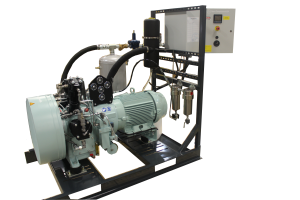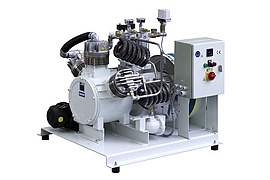As industrial compressed air quality standards continue to evolve, so does Sauer’s commitment to exceeding quality expectations in a variety of ways. Today, the International Standards Organization’s (ISO) 8573 series of codes is the generally accepted standard of choice in specifying the purity of compressed air required from a compressed air system. In this article, we’ll present two ways to meet and exceed ISO8573-1 standards using Sauer technology and expertise.
Meeting Specifications
It’s helpful to understand the breakdown of the ISO8573 standard when writing or reviewing specifications on a compressed air project. ISO8573 consists of nine parts, differentiated with a “-1” style suffix.
- ISO8573-1:2010 = Part 1, Specifies the amount of contamination allowable in each cubic meter of compressed air
- ISO8573-2:2007 = Part 2, Specifies the test method for oil aerosol
- ISO8573-3:1999 = Part 3, Specifies the test method for humidity
- ISO8573-4:2001 = Part 4, Specifies the test method for solid particulates
- ISO8573-5:2001 = Part 5, Specifies the test method for oil vapor and organic solvents
- ISO8573-6:2003 = Part 6, Specifies the test method for gaseous contaminants
- ISO8573-7:2003 = Part 7, Specifies the test method for viable microbiological contaminants
- ISO8573-8:2004 = Part 8, Specifies the test method for solid particles by mass concentration
- ISO8573-9:2004 = Part 9, Specifies the test method for liquid water
New installations or modifications should be specified against Part 1 (ISO8573-1). The remaining sub-sections should be considered for determining physical testing points during design, and later upon startup to complete validation testing. We point out this sub-section breakdown to clear up some confusion we see in equipment designs from time to time, where contaminant statements from Parts 2 through 9 make their way into equipment specs, perhaps from the misunderstanding of how each Part applies to the project.
In ISO8573-1, specifications are included to govern allowable levels of particulate, water, oil, gaseous (vaporous), and microbiological contaminants. The standard goes on to list different pre-defined levels of quality, called Classes, that set decreasing levels of contaminant content as the Class number decreases from Class X (lowest quality) to Class 0 (highest quality).

From the chart above, we see the relationship between lower Class numbers and lower contaminant content. For most industrial projects, Class 1 or Class 2 are set as the quality specification for the compressed air system at the compressor room. In certain application
s, air that is delivered downstream into points of use may have a higher Class specified at that use point, inferring that additional filtration or treatment is needed at that connection. However, even if the Classes at both the compressor room and point of use are the same, additional treatment is usually needed at the use point in order to remove any contaminants gained from the piping system.
Lastly, it’s worth pointing out that systems can be specified with a mix-match of Classes. To do this, a set of numbers is added to the end of the specification, stating the value for each Class of the three contaminant types: Particles, Water, and Oil. For example, a specification written as “ISO8573-1:2010 [2,1,1]”, translates to Class 2 for Particulates, Class 1 for Water, and Class 1 for Oil, on this project.
Now that we have our standards defined, how do we obtain the common Class 1 or Class 2 air qualities? Do we need oil-free compressors, complex filtration, or special equipment? We’ll describe two options from Sauer Compressors next, offering options from capital cost, operating cost, and maintenance perspectives.
Sauer Lubricated Compressors
Class 1 and 2 air qualities specify <0.01 and <0.1 mg/m3 respectively of oil liquid, aerosol, or vapor in the air stream. Do we need an oil-free air compressor to achieve Class 1 or 2 air? No, we don’t!
The Sauer Oil-Lubricated line of reciprocating piston air compressors is the first option towards obtaining high-quality compressed air. With proper downstream filtration and treatment, you will not sacrifice any air quality using an oil-lubricated compressor over an oil-free compressor. Even better, you’ll often reduce cost, have a longer lifespan, and can stretch our maintenance intervals by monitoring oil quality.

Sauer offers two main categories of Oil-Lubricated Air Compressors: air-cooled and water-cooled.
Sauer’s air-cooled compressors span five unique styles, ranging from 2 stage, 2 cylinder models in the Mistral Series, up to 4 stage, 4 cylinder models in the Tornado series, and can achieve up to 6,090 PSI operating pressure. Sauer’s air-cooled compressors feature many options, including direct drives, long life, continuous duty, and extreme environment compatibility.
Sauer’s water-cooled compressors cover three styles, ranging from 2 stage, 2 cylinder models in the Typhoon Series, up to 5 stage, 6 cylinder models in the 6000 Series, and can achieve up to 7,250 PSI operating pressure. Sauer’s water-cooled options provide solutions for low airflow, high ambient temperature, noise-sensitive, and very high operating pressure applications.
Meeting Class 1 or Class 2 air with a Sauer oil-lubricated air compressor is easily obtainable by placing downstream air treatment components specified to meet the required quality levels. Treatment and filtration are required for both oil-lubricated and oil-free compressors, so we’ll cover those options after next describing our oil-free compressors.
HAUG and Sauer Oil-Free Compressors
Oil-free compressors present even more options to obtain Class 1 or Class 2 high-quality compressed air. Oil-free compressors are beneficial in particular applications, as they remove the potential risk of lubricating oil carrying over into the air stream as the air passes through compressor stages. There is still the need for downstream filtration to treat all other sources of air contaminants, but generally speaking, the treatment levels needed would be relatively lower compared to oil-lubricated compressors. Beyond this fact, oil-free compressors can offer benefits such as lower operating costs, lighter and smaller sizes, and the environmental benefits of reducing the need for lubricating oils.
Let’s take a look at two solutions for oil-free air compressors: Sauer’s direct line of air-cooled Harmattan units, and our affiliate manufacturer HAUG’s offerings.
Sauer’s air-cooled, oil-free Harmattan series of air compressors come in 2 stage, 2 to 4 cylinder configurations, with operating pressures up to 218 PSI. The Harmattan design uses no oil in either the compression stages or the crankcase, providing a totally oil-free installation. These compressors also feature a flat construction with horizontal cylinders, allowing for easier maintenance and less head clearance required for installation. Fully mass balanced, one-piece bearings, vertically split crankcase, and silent, smooth operation are all standard benefits of the Harmattan series.
HAUG’s air-cooled, oil-free air compressor offerings come in three models: Cygnus, Taurus, and Orion. These models are all reciprocating piston same as the Harmattan series, completely oil-free,

air-cooled compressors (with the Orion having optional water-cooling available). With 1 to 3 stages and 1 to 4 cylinders, HAUG’s compressors can reach up to 870 PSI operating pressure.
In demanding market sectors such as food, electronic, pharmaceutical, and medical device manufacturing, oil-free air compressors have become the industry standard. The use of an oil-free compressor in these applications allows for fewer contamination risk points in the overall system, removing compressor lube oil from the equation. Class 1 or Class 0 air quality levels are more easily obtained when oil-free compressors are at the heart of the air system.
The Common Link: Filtration
No matter which compressor type you chose – oil-lubricated or oil-free – filters and treatment equipment is required downstream of the compressor in order to filter our airborne particulates, vapors, aerosols, liquid, and microorganism.
Sauer designs and builds full air compressor systems which include all downstream treatment needed to hit your specification. Filters, dryers, separators, receivers – all can be packaged into our designs. Every order is custom-built, with components selected specific to your quality requirements, allowing us to guarantee that Class 2, 1, or 0 air is produced.
Sauer’s offers a robust line of desiccant and refrigerated dryers, particulate filters, oil and vapor filters, oil/water separators, and sterile filters. Having these components included in the system design is half of the challenge – the other half is assuring that they are placed in the system strategically to the points of use where high-quality air is needed, as well as installing redundancy to assure total process protection. We can help recommend installation scenarios from the compressor room fully out to each and every point of use.
Whether Sauer and HAUG, oil-lubricated or oil-free, our engineers are ready to assist in reviewing your project and recommending the ideal system for your application. In all cases, post-compressor filtration is required to assure high ISO Class air quality, and we’d be happy to discuss the options with you. For more information or to ask any questions, please visit our website at http://www.sauerusa.com/.

You must be logged in to post a comment.